891 Search Results for core vocabulary
June 21, 2017
by Carole Zangari -
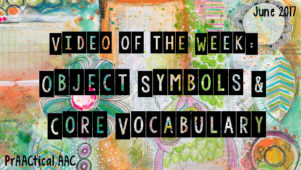
Figuring out the best way to represent language to someone who will be communicating through AAC is challenging, but when the client is unable to see well enough to use pictures, the task is infinitely more complex. In this week’s featured video, Dr. Kathy Howery provides an overview of the 3D tactile symbols created by the Center for Literacy and Disability Studies at the University of North Carolina Chapel Hill for high frequency core words. If you work with individuals who are blind or have very low vision, this important video is one you may want to share with the whole team. You can access the accompanying handout here. Many thanks to Kathy Howery and Edmonton Regional Learning Consortium for creating this video and making it available to us all.
June 12, 2017
by Carole Zangari -
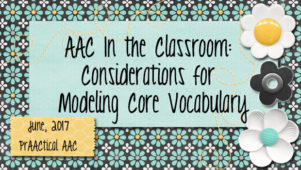
Here in the US, many schools just let out for summer vacation but some special education teachers and SLPs are already thinking about things they want to prepare over the school break so they’ll be ready for fall. Some are contemplating changes to the ways they support AAC in the classroom. We’ve heard from several who are planning to prioritize modeling of core vocabulary using aided language input. Before we start making large core boards and other support materials, though, it’s helpful to stop and think through some important issues. A little planning now will save time and effort in the long run. If you’re planning to do this kind of prep work over the summer, here are some questions for your team to consider. Does each student with complex communication needs have access to an AAC system that includes core vocabulary? If not, why not? In some cases, the students... [Read More...]
June 1, 2017
by Carole Zangari -
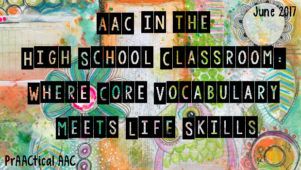
Today, guest blogger Sarah Mueller, a special education teacher in Rochester Michigan, shares her thoughts on supporting core vocabulary learning while working on functional life skills. Sarah teaches high school students with intellectual and developmental disabilities and strives to embed language and communication throughout her students’ entire school experience. Sarah helps her students become strong self-advocates as they prepare for adult life. Marlene Cummings, Sarah’s colleague and mentor, introduces the post. :::::::::::::::::::::::::::::::::::::::::::::::::::::::::::::::::::::::::::::::::::::: I (Marlene Cummings) had the pleasure of meeting Sarah 2 years ago as a new teacher in one of my districts. She immediately engaged in our county level professional learning opportunities in AAC and Literacy. The AAC focus presented strategies to support AAC and language learning including: core vocabulary, aided language input, vocabulary instruction and opportunities. The literacy focus was designed to create and implement a comprehensive literacy program taught by Drs. Karen Erickson and David Koppenhaver. The outcome:... [Read More...]
April 27, 2017
by Carole Zangari -
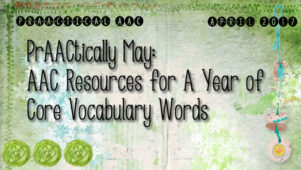
It is just about time to flip the calendar to a new page, and that means it’s time for a new set of core words to model, elicit, and practice. In this post, we have a number of resources and an announcement (**scroll to the bottom**) for those who’ve tried their hand at implementation. Thanks to all who’ve reached out with questions, comments, and words of appreciation for the Year of Core Vocabulary series. Here are some helpful resources for those who are using the words in Set 1 ( 2013 Year of Core Words) or Set 2 (Another Year of Core Words). If you are contemplating this approach, feel free to jump in at any time. The best time to start (or re-start) is right now. Don’t worry about retracing steps, or not ‘doing it right.’ The best way to get better at core vocabulary instruction is just to... [Read More...]
April 3, 2017
by Carole Zangari -
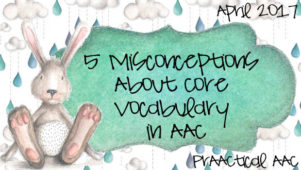
When we first started writing about core vocabulary, it was largely due to the fact that most SGDs, AAC apps, and communication boards/ books had two big deficits. At the time, most of them lacked the words needed to function throughout the day and/or didn’t have the kinds of words that allow for progression of syntactic skills. Now things look very different. Over the years, the pendulum has moved quite dramatically and now core vocabulary permeates AAC systems that are considered to be ‘robust.’ That’s a lot of movement in a short period of time. When big changes happen rapidly, it stands to reason that there will be some cracks that open up. Misunderstandings, misinterpretations, misconceptions. Here are some of the ones we’ve observed in the recent past. Core words are all that are needed in an AAC system. (Not in most cases. We all want to talk about the... [Read More...]
March 29, 2017
by Carole Zangari -
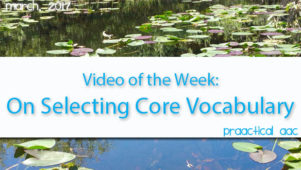
Ensuring that AAC systems include high frequency words sets the stage for us to teach language that is flexible and functional across a variety of settings. For whom is that appropriate? How many words? Which ones? In today’s featured video, master clinician Gail Van Tatenhove tackles all of these issues and more. This video and the accompanying resources (which can be found here) were part of the Power AAC series Gail created for PaATTAN to support their efforts in building capacity for high quality AAC services. We’re indebted to them for making this available so all can learn from it.
March 22, 2017
by Carole Zangari -
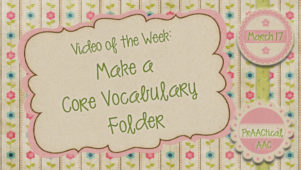
Looking for a core+fringe AAC display that is easy to make and not overwhelming to use? This post may have just what you need. It’s great to see the variety of ways in which professionals are embracing AAC options and using what they know to teach others. In today’s post, we feature a video by the Louisiana South/Central Regional AT Center in which they take us through the step-by-step process of making a versatile AAC support that can be a wonderful starting point for some of our learners. In addition to the video, this generous team shares their files so you can make one of your own (click here to download; you can get the SymbolStix version here) and even share the source for the vinyl pockets they use. Pretty prAACtical! Thanks, Louisiana South/Central Regional AT Center, for your collegiality in sharing this with all of us!
March 2, 2017
by Carole Zangari -
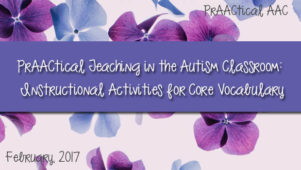
“But I don’t have just one student who needs AAC in my class – I have a bunch! How can I work AAC teaching into an already hectic day?” Teachers Amy Devin and Lauren Pawlowski are back with real-world suggestions for situations like these. Last year, they introduced us to Big Core, gave us tips for implementing it in the classroom, and explained how they integrate it into shared reading lessons and predictable chart writing activities. Today, they’re back with prAACtical information on how they provide explicit instruction on core vocabulary words. Amy and Lauren are public school teachers in Michigan who began teaching in resource rooms and moved to self‐contained ASD elementary classrooms in 2009. There was not much talk about core language when they started teaching and even less about incorporating into classroom lessons. AAC devices have changed a bit over the years, too. Initially, they worked with a 32-location core board on... [Read More...]
February 27, 2017
by Carole Zangari -
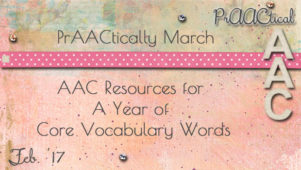
Do the AAC users in your life use only a fraction of the core words in their SGD, AAC app, or communication board? One way to help them move forward is to make a concerted effort to use, highlight, and provide additional teaching on a variety of words. It’s hard to do this without getting overwhelmed, so find a strategy that works for you. A few years ago, we decided to approach this by focusing on 12-16 core words each month. (If this is too much for the teams with whom you work, that’s not a problem. Just cut it back to 4-6 words/month.) Each month, we can highlight those words in our conversation (aided language input), direct intervention, and home programming activities with AAC learners. The repeated experiences with those 12-16 (or 4-6) words helps our AAC learners develop new skills, and keeps the team focused on the same destination. It’s... [Read More...]
February 9, 2017
by Carole Zangari -
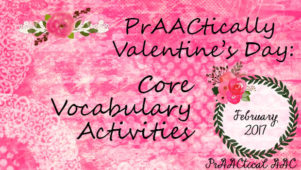
Looking for ways to build fluency with core vocabulary as you prepare for Valentine’s Day festivities? Here are a few suggestions. Making Cards: Get your crafting on and make some cards, like these from Christine Dunbar. Core word practice: pronouns (I, you, it, they); verbs (do, make, get, help, like); descriptors (pink, little, some), prepositions (on), determiners (this, that, these, those); interrogatives (what, where) Deliver the Cards: Have some fun being a mail carrier, delivering Valentine cards, and interacting with all the recipients. We love this mini schedule by the Considerate Classroom. Core word practice: pronouns (I, you, it, we); action verbs (go, give, get, see, take); locatives (here, there); social words (hi, thank you); determiners (this, these); interrogatives (who, where) Play Valentine Bingo: Thanks, Katie Millican and Jessica Maldonado! Core word practice: pronouns (me, my, he, she); verbs (can, have, need, get, want, play); descriptors (big, round, red); interrogatives (where,... [Read More...]









